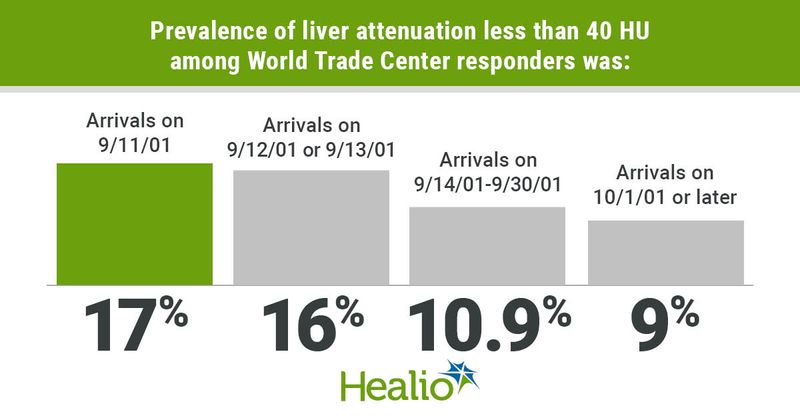World Trade Center early responders have increased hepatic steatosis
Increased hepatic steatosis was observed among responders who arrived earlier at the World Trade Center site, according to a study published in American Journal of Industrial Medicine.
“The bottom line is that responders to the World Trade Center attack who had more intense exposure to the site had a higher likelihood of having an excessive accumulation of fat in their livers than responders who arrived at the site later and had less exposure,” Andrea D. Branch, PhD, professor of medicine (Liver Diseases) at Icahn Mount Sinai, told Healio Gastroenterology. “Individuals with this abnormality, which the research team detected by analyzing chest CT scans that were typically to evaluate respiratory symptoms, may benefit from referral to a liver specialist (hepatologist). The next step in the research, which will be funded by a grant from the [National Institute for Occupational Safety and Health (NIOSH)]/CDC, will be to determine whether responders with excessive liver fat also have increased liver scarring. Liver scarring can lead to cirrhosis. Individuals with cirrhosis are advised to enroll in liver cancer screening, which is available at many locations within the Mount Sinai health network.”

As part of the World Trade Center health program, Branch and colleagues collected and reviewed low-dose CT scans of the chest performed on 1,788 World Trade Center general responders between September 11, 2001, and December 31, 2018. Investigators categorized World Trade Center dust exposure into five groups based on arrival time to the World Trade Center. They used the Statistics-based Liver Density Estimation from Imaging algorithm was used to estimate the CT liver density and univariate and multivariable regression analyses to assess the correlation between the intensity of World Trade Center dust exposure and the risk for hepatic exposure.
Of the 1,788 WTC responders, Branch and colleagues reported 258 had liver attenuation Hounsfield units (HU) less than 40 on their earliest CT scan. Median time between September 11, 2001, and the earliest available CT scan was 11.3 years.
“Prevalence of liver attenuation [less than 40] HU was 17% for arrivals on [Sept. 11, 2001], 16% for arrivals on [Sept. 12 or 13, 2001], 10.9% for arrivals on [Sept. 14-30, 2001] and 9% for arrivals on [October 1, 2001] or later (P = .0015),” the researchers wrote.
According to Branch and colleagues, increased liver steatosis was seen with earlier arrival times (P < .0001).
After controlling for other covariates, World Trade Center arrival time was still a significant independent factor for decreased liver attenuation.

